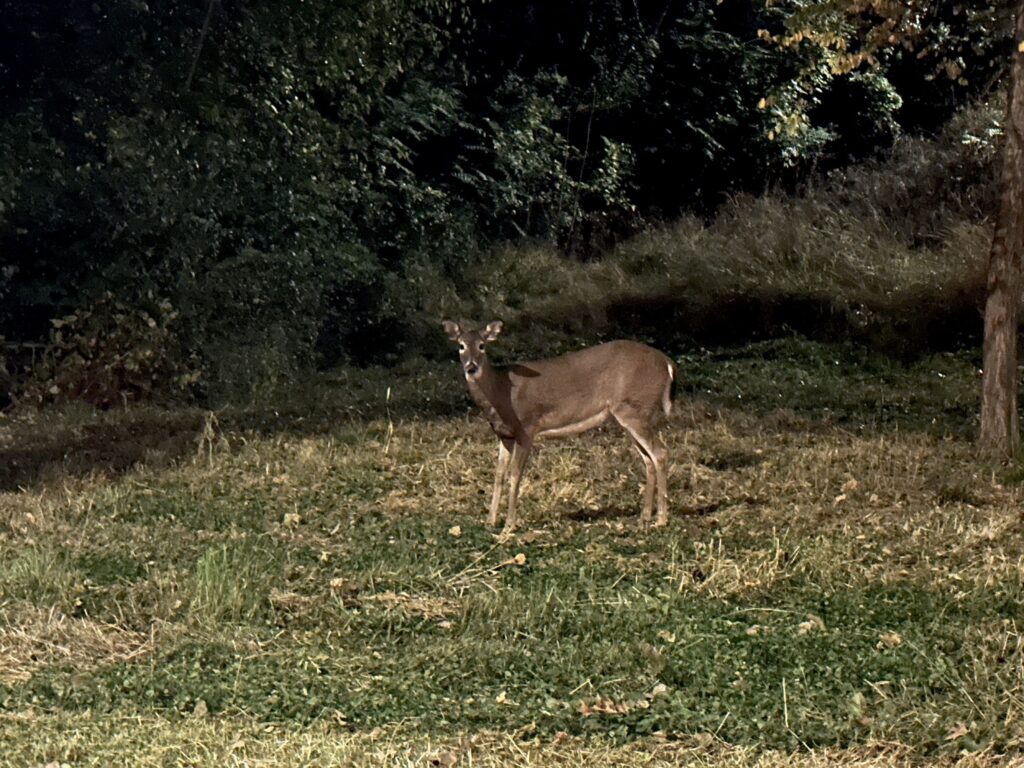A deer in Greenwood-Ashworth park in Des Moines. (Photo by Karsan Turner for Iowa Capital Dispatch)
A population density study of white-tailed deer in Iowa confirmed what most Department of Natural Resources specialists suspected: deer populations are highest where their habitats are most intact.
The report also estimated the economic impacts and found deer are an economic benefit in Iowa, with $181 million in tangible value and only costing Iowans $138 million in an average year. Researchers on the report, however, note that most of the values reported for economic loss represent the low end of the range and actual losses could be higher.
The study is a result of a 2022 law that, among other things, tasked DNR, Iowa Department of Transportation, representatives of Iowa State University and the Iowa Insurance Division, with conducting a deer population density study to be completed and submitted every three years.
According to the report, deer populations were highest in south-central and northeastern Iowa, where tall grasses and forest structures are most intact. An analysis of populations over time showed that only 12 counties have had increasing population trends since 1996.
Researchers used several methods to calculate the population density, including an observation survey from bow hunters, buck harvests, deer-collision reports and a nocturnal spring spotlight survey where DNR staff drive on approximately 50 miles of gravel roads in each county and count the number of deer they see in a spotlight.
Adam Janke, a professor at Iowa State University and wildlife expert, wrote in a section of the report that wildlife are “inherently difficult to observe” and exact population counts are “rarely feasible for wildlife.”
These data sets create a series of population trend indexes which researchers use to estimate population changes from year to year.
A map shows deer population density by county in a new study conducted by Iowa Department of Natural Resources and the Department of Natural Resource Ecology and Management at Iowa State University. (Map courtesy of Iowa DNR and ISU)
Jace Elliott, the state deer biologist, presented the report briefly at an Iowa Natural Resources Commission meeting Thursday. Commissioners took interest in the report and decided to schedule a lunch-and-learn session to look at it in more depth.
“It’s by no means a perfect count of deer,” Elliott said. “But it’s a pretty robust way to look at how deer density compares in different counties.”
The research team was also tasked with calculating the cost of deer populations to the state.
The report found the minimum tangible value of deer to Iowa is $181 million per year. This figure accounts for hunting expenditures, licensing costs, meat processing, venison and taxidermy. A large part of that figure comes from the value of venison, which the report found to be on average $24 million annually.
“From a recreational standpoint, deer are arguably the most important and economically valuable wildlife species in Iowa, and a key aspect of Iowa’s tourism-oriented approach to economic development,” the report reads.
Deer cause a minimum amount of $129 million in vehicle collision costs annually, and an additional $10,000 in aircraft collision costs, though only two deer-aircraft collisions have been reported in Iowa over the past 10 years.
Approximately 0.31% of harvested row crops are damaged or lost annually, with a conservative estimated cost of $5.2 million. This figure was calculated using an adjusted study from 1996 and only accounts for consumption of grain and doesn’t include trampling or other damage deer can cause to crops.
Elliott said during an Iowa Natural Resource Commission meeting Thursday his department is drafting a research proposal to work with ISU again and estimate total crop damage from wildlife.
“This would be another significant investment to pursue, but we know that it’s one of the most important wildlife research questions that we can answer in Iowa,” Elliott said.
Specialty crops, like fruits, vegetables, nuts and Christmas trees are more susceptible to damage from deer. Surveyed farms reported, on average, 24% of their farmed acreage was affected. The ISU researchers who worked on the report calculated that, collectively, specialty croppers in Iowa experience $3.4 million in deer-related losses annually and spend an additional $832,000 per year on deer management strategies.
A new study conducted by Iowa Department of Natural Resources and the Department of Natural Resource Ecology and Management at Iowa State University calculated the estimated losses to specialty crops from deer. (Map from the report)
Iowa deer populations fluctuate due to disease and changes in habitat, but are also controlled by hunting female deer. Iowa DNR engages hunters and landowners across the state, in addition to various data sets, to inform its deer management programs and create county-specific plans.
Elliott said this report, and its subsequent iterations, will allow for more informed deer management and understanding.
“The future success of deer population management in Iowa relies on the ability to consider all available sources of data and public input through an engaged stakeholder process in order to guide county-based harvest strategies,” Elliott wrote in the report.
YOU MAKE OUR WORK POSSIBLE.

